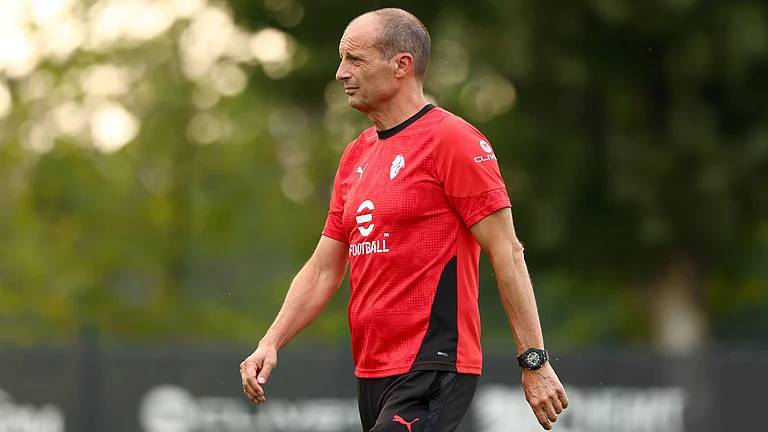Man’s quest to play God seems to have become irrepressible. What better way of sublimating this instinct, then, than to harness breathtaking scientific breakthroughs to create life itself in the laboratory. But this wasn’t what prompted Radha Krishnakumar to apply for a slot on the exclusive team of the eponymous J. Craig Venter Institute (JCVI), the genomic research organisation based in Rockville, Maryland, that has created the world’s first synthetic bacterial cell. Her inspiration was altruistic, though she did feel the excitement course through her as she read in a journal about the incredible plan of scientist J. Craig Venter. As Radha told Outlook, “Immediately I saw the huge benefits and implications of such an achievement and wanted to be a part of it.”

Sanjay Vashee, Assistant professor
The India Connection: Grandfather left Gujarat for Zimbabwe, his mother was raised in Dhanori, Gujarat, and his wife is from Surat: “I have several aunts and many cousins who still reside in Gujarat.... Our team worked very hard and each member set aside his or her ego to get the job done.”
She applied for a job at JCVI in 2006 and received a nod from Prof John Glass, who specialises in synthetic biology. He placed her on the 25-member team tasked with creating a synthetic bacterial cell. On the team were two other Indians—Sanjay Vashee and Prashanth P. Parmar. Glass says he recruited her and selected the other two Indians because he was struck by their ability to solve difficult scientific problems. “I could not be more proud of the tremendous work they—Sanjay, Radha and Prashanth—have done in researching this extraordinary scientific milestone,” he said of his juniors.
Burning the midnight oil for 15 long years and incurring an expenditure of $40 million, Venter and his team succeeded in constructing the first self-replicating, synthetic bacterial cell. The feat naturally generated a frisson of excitement around the world, grabbing headlines across continents. As Radha says, “Our synthetic biology team has taken the first successful step towards making designer bacteria. This was accomplished by writing a modified genetic code using the genome of an existing bacterium, synthesising and assembling this new genome, and then transplanting the genome into a closely related bacterial cell.” This cell continued to multiply and, more important, some of its offspring had only the JCVI-made genome. Clyde Hutchison, a senior member of the Venter team, says, “The most remarkable thing about our synthetic cell is that its genome was designed on the computer and brought to life through chemical synthesis, without using any pieces of natural DNA. This involved developing many new and useful methods along the way.”
Some hail Venter, saying he has created artificial life; others say it’s merely akin to genetic engineering on a massive scale. But just about every science pundit agrees that it’s perhaps the most important scientific breakthrough of this millennium. Decidedly the mind of the team, Venter was once described thus by the Washington Post: “Either he is one of this era’s most electrifying scientists, or he’s one of the most maddening.” Mad or brilliant or both, he was on the pages of just about every newspaper around the world. To Outlook, though, Venter describes the creation of the world’s first synthetic cell as a “team effort that would not have happened without the skills and expertise of all, including Sanjay, Radha and Prashanth.”
Indeed, such scientific breakthroughs are usually a team effort. But this shouldn’t suggest that the three Indians played a peripheral role in the creation of a synthetic cell. Listen to the praise Glass lavishes on Radha: “She’s a gifted scientist with superb skills in molecular biology and microbiology.” Her inclusion in the JCVI team is as much an eloquent testimony to the brilliance of the Indian mind as it is to the American system’s quality of attracting talent from around the world—and according it due prominence.
It was only in 2000 that Radha flew down to the US to pursue a PhD in microbiology from the University of Illinois at Urbana-Champaign, after completing her BSc from Mount Carmel College, Bangalore, and MSc from Bharathidasan University, Tiruchirapalli. Six years later, she was a member of one of the world’s most important research teams, bringing to it her expertise in the creation of a strain of Mycoplasma—a kind of bacterium—with the capacity to metabolise 21 amino acids.
The presence of Sanjay Vashee in the JCVI team speaks more of the wanderlust of Indians, particularly Gujaratis. In the 1920s, Vashee’s grandfather shifted from his village, Sari Bujarang in Gujarat, to—believe it or not—Bulawayo in Zimbabwe. But he remains steeped in the Indian tradition largely because his mother, Manjulaben, was born and raised in Dhanori, Gujarat, and his wife, Rita, is from Surat. “I have several aunts and many cousins who still reside in Gujarat,” Vashee says, stressing upon his ancestral Gujarati roots.
Vashee, too, studied at the University of Illinois at Urbana-Champaign, got an MS from Western Illinois University, and did his PhD at the University of Texas at Austin. Not among those eager to appropriate credit, Vashee says the team’s astounding feat can be ascribed to the fact that every member worked “very hard, setting aside his or her ego to get the job done.” About the potential benefits of the breakthrough, Vashee says, “It should now become more possible to design or engineer new organisms to produce such things as biofuels, pharmaceuticals etc. This technology should also allow us to possibly begin to work with genetically intractable pathogens so that we may be able to understand them better and hence treat more easily the diseases they cause.”
Both Vashee and Radha assisted Dan Gibson, a senior member of the team, in the construction of the synthetic genome that created the new bacterium. About the challenges they had to overcome, Gibson says, “To produce a synthetic cell, our group had to learn how to sequence, synthesise and transplant genomes. Many hurdles had to be overcome, but we are now able to combine all of these steps to produce synthetic cells in the laboratory. We can now begin working on our ultimate objective of synthesising a minimal cell containing only the genes necessary to sustain life in its simplest form. This will help us better understand how cells work.”

Prashanth Parmar, Reasearch Associate
The India Connection: Born in Surat, moved to the US as a five-year old: “I am delighted at this achievement, especially in light of how long and hard many of us have been working on this project. I am thankful to God that I was able to contribute to it.”
The third Indian member of the team is Prashanth P. Parmar, a research associate at JCVI’s Pathogen Functional Genomics Resource Center. Born in Surat, he moved with his family to the US at the age of five. He says he has been interested in science for as long as he can remember. He candidly says he did not play a direct role in the creation of the synthetic cells, but was responsible for performing experiments to help characterise them. About Parmar, Glass gushes, “Prashanth is an expert at proteomics. When I needed to have two-dimensional protein gels done to characterise synthetic cells, I knew just who I wanted to perform that analysis.”
Parmar says he is delighted at the team’s achievement, “especially in light of how long and hard many of us have been working on this project. The implications of the research for energy and pharmaceutical development are very exciting”. Those who accuse Venter and his team of playing God should hear what Parmar says: “I am thankful to God that I was able to contribute.”
But such remarks, obviously, won’t convince critics, who are appalled at Venter’s scientific ambitions. As Julian Savulescu, professor of practical ethics at Oxford University, told the Guardian: “Venter is creaking open the most profound door in humanity’s history, potentially peeking into its destiny. He is not merely copying life artificially...or modifying it radically by genetic engineering. He is going towards the role of a god: creating artificial life that could never have existed naturally.”
Others worry that such synthetic cells, if accidentally released into nature, could cause environmental havoc and worse, if in the hands of rogue scientists, could be developed into dangerous biological weapons. In December 2008, JCVI received funding from the Alfred P. Sloan Foundation to examine such ethical and societal concerns that are associated with the developing science of synthetic genomics. Venter admits these are “important questions and ones that we have asked since the beginning of the first questions and experiments in this area”. But the maverick scientist is already looking ahead. “We have said this is a small step and a proof of concept,” he says. “There will now be more work to understand the minimal components of life and how we can use the research and technologies we developed to create useful products such as vaccines and new biofuels.” Hopefully, there’s no scientist around wishing to become a destructive god of the future.


























